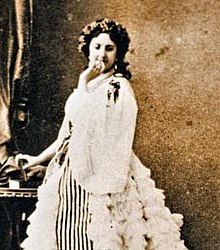Anne Deslions
French courtesan during the Second French Empire
You can help expand this article with text translated from the corresponding article in Swedish. (March 2021) Click [show] for important translation instructions.
- View a machine-translated version of the Swedish article.
- Machine translation, like DeepL or Google Translate, is a useful starting point for translations, but translators must revise errors as necessary and confirm that the translation is accurate, rather than simply copy-pasting machine-translated text into the English Wikipedia.
- Do not translate text that appears unreliable or low-quality. If possible, verify the text with references provided in the foreign-language article.
- You must provide copyright attribution in the edit summary accompanying your translation by providing an interlanguage link to the source of your translation. A model attribution edit summary is
Content in this edit is translated from the existing Swedish Wikipedia article at [[:sv:Anne Deslions]]; see its history for attribution. - You may also add the template
{{Translated|sv|Anne Deslions}}to the talk page. - For more guidance, see Wikipedia:Translation.


Anne Deslions (died 1873) was a French courtesan, one of the most famous demimonde courtesans during the Second Empire.[1]
She was born in poverty, and ran away from a brothel at the age of sixteen, after which she was established as a high class courtesan in Paris. One of her most known clients were Prince Napoléon Bonaparte.[2][3]
She has been pointed out as the role model for the character of Nana by Émile Zola.[2][4]
A French potato dish, Pommes de terre Annette or Pommes Anna, was created and named by French chef Adolphe Dugléré for Anna Deslions, who frequented Dugléré's Café Anglais (Paris).
References
- ^ Granström, Alvar, Kvinnor och krinoliner: en mode- och sedeskildring från krinolinmodets tid, Carlsson, Stockholm, 1990
- ^ a b Branda, Pierre (2021-01-07). La saga des Bonaparte (in French). Place des éditeurs. ISBN 978-2-262-09481-2.
- ^ Marwick, Arthur (2007-06-21). A History of Human Beauty. A&C Black. ISBN 978-0-8264-3945-1.
- ^ Granström, Alvar, Kvinnor och krinoliner: en mode- och sedeskildring från krinolinmodets tid, Carlsson, Stockholm, 1990











